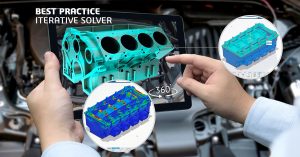Have you been to the SIMULIA Community lately? If you want the best content, access to our verified SIMULIA experts, a forum to ask questions, and more, then this is the place for you! Our community is engaged and informed about the latest in simulation trends, as well as providing solutions to complex engineering problems. And if you want access to Best Practice documents like Simulation Using the Iterative Solver Technology in Abaqus all you need to do is join for free!
This is a post in the series SIMULIA Community Best Practices featured on the blog. Come back for more posts about SIMULA Best Practices and other interesting simulation content.
The demand for solving very large structural simulation problems continually increases. Ten years ago, it was a dream for finite element analysts to solve structural problems with 50 to 100 million degrees of freedom; today, with the evolution of software and supporting hardware, this has become a reality. 
Direct sparse solver technology, the default approach in many mainstream commercial FEA packages, has limits when used with very large models. The number of floating point operations required to factorize large stiffness matrices grows quickly as model size increases, particularly for models using solid elements.
Iterative solver technology provides a fast, scalable alternative. By enabling the solution of models that are prohibitively large for direct solvers, iterative solvers are powerful tools for achieving high fidelity solutions. Together with the high performance modeling, meshing, and visualization capabilities of the 3DEXPERIENCE platform, this technology empowers structural and mechanical analysts with a new tool to handle large, real-world simulation models with over 200 million degrees of freedom.
This document describes best practices for a new, state-of-the-art iterative linear equation solver in Abaqus/Standard and the 3DEXPERIENCE structural simulation apps.
The new solution capability is built on an original, proprietary algorithm developed for reliability, efficiency, and lean memory management. A scalable parallel implementation results in a very fast, low memory consumption solver well suited for very large models.
The iterative solver is best suited to models with certain characteristics. Specifically, the iterative solver is best suited for models with a high degree of mesh connectivity and a relatively low degree of mesh sparsity; such models are typically referred to as “blocky” are most often simulated with three dimensional solid elements. In this document we provide usage guidelines and strategies to help you best utilize this technology.
Target Audience: Structural and Mechanical Analysts that develop large, computationally intensive finite element models.
In this Best Practice, you will learn about:
- What model types are best suited for the iterative solver.
- How to access the iterative solver on the 3DEXPERIENCE platform.
- Optimal settings for launching and running the iterative solver.
Looking for more Best Practices? Get them HERE.
*Please note that you will need a valid DS Passport account with appropriate user role to access Best Practice Documents. Please contact your Dassault Systèmes representative for issues related to your account.
SIMULIA offers an advanced simulation product portfolio, including Abaqus, Isight, fe-safe, Tosca, Simpoe-Mold, SIMPACK, CST Studio Suite, XFlow, PowerFLOW and more. The SIMULIA Community is the place to find the latest resources for SIMULIA software and to collaborate with other users. The key that unlocks the door of innovative thinking and knowledge building, the SIMULIA Community provides you with the tools you need to expand your knowledge, whenever and wherever.


